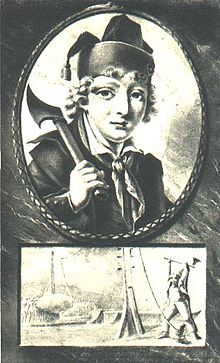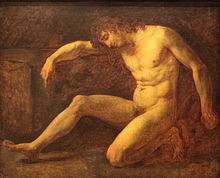Joseph Agricol Viala

Joseph Agricol Viala (born September 22, 1780 in Avignon , † July 6, 1793 in Caumont-sur-Durance ) was a French national guard and a well-known figure of the French Revolution .
Life
Viala was living in Avignon when a federalist uprising broke out in 1793 after the fall of the Girondins in Paris . Backed by the British, the royalists allied with the federalists and took control of Toulon and Marseille . Faced with this revolt, the soldiers of the French First Republic were forced to retreat towards Avignon and leave Nîmes , Aix and Arles , where Provencal uprisings were raging. The residents of Lambesc and Tarascon joined the rebels from Marseilles and headed for the Durance to march on Lyon , where they were also in revolt against the Parisian authorities. It was hoped to be able to smash the National Convention and thus put an end to the revolution.
As the nephew of Agricol Moureau (1766–1842), an Avignon Jacobin , editor of the Courrier d'Avignon and administrator of the newly created department of Vaucluse , Viala was commanding the "Espérance de la Patrie" (Hope of the Fatherland), the national guard of the young Avignonese .
When the news arrived in early July 1793 that the insurgents from Marseilles were approaching, the republicans, mainly those from Avignon, gathered to prevent them from crossing the Durance. Viala joined the Avignon National Guard. Outnumbered, the only solution was to cut the ropes of the ferry from Bonpas , under fire from the insurgents. To do this, an open embankment had to be crossed, on which one was exposed to the muskets of the rebels and behind which the Republicans now holed up. The Republicans hesitated, considering the operation too dangerous.
According to traditional reports, the twelve-year-old Viala is said to have taken an ax and thrown himself onto the main rope of the ferry, which he attacked with several blows. Several musket shots were fired at him immediately. Viala was shot and mortally wounded.
The use of Viala could not prevent the insurgents crossing. Nonetheless, he enabled the Republicans to withdraw, leaving the boy's body behind. One of his comrades, who is said to have heard his last slogans, tried to bring it back, but had to back down from the advancing royalists. They allegedly mutilated the body and threw it into the river. As a lesson from the death of her son, Viala's mother is said to have said: "Yes [...], he died for the fatherland!"
reception

Viala is, together with Bara , one of the most famous young hero characters of the French Revolution, who appears, however, a little late. De facto, the Jacobean press did not mention him before Pluviôse II. It was above all the speech given by Robespierre to the National Convention on May 7, 1794 ( 18th Floréal ) that made him famous. In the Prairial , Claude-François de Payan published a Précis historique sur Agricol Viala , which contributed to the popularization of Vialas. The first performance of the patriotic opera act Agricol Viala, ou Le jeune héros de la Durance , composed by Louis Emmanuel Jadin (1768-1853) took place on July 1, 1794 (13 Messidor An II) at the Théâtre des Amis de la Patrie in Paris. At the request of Bertrand Barère , the assembly voted for an honor in the Panthéon , which was never realized. Originally the intended ceremony was to take place on July 18th ( 30th Messidor ). However, it was moved to July 28th ( 10th Thermidor ) of the year II, one day after the fall of Robespierre . In Avignon, for the 30th Messidor, a citizens' festival “in memory of Bara and Viala” was organized.
The engraver Pierre-Michel Alix (1762-1817) created a bust portrait of Viala.
In the old national anthem Le Chant du Départ by Marie-Joseph Chénier , Viala is honored with a verse sung by a child's voice:
| De Barra, de Viala le sort nous fait envie; Ils sont morts, maize ils ont vaincu. |
The fate of Barras and Vialas makes us jealous, You died and yet prevailed. |
He is one of the 660 personalities whose name is engraved under the Arc de Triomphe and appears in the 18th column .
In the context of the memorial battle between the Republicans and their opponents, local scholars who were hostile to the revolution claimed that Viala had provoked the insurgents with rude gestures. It seems like the main aim is to target his uncle, the l'homme rouge .
In 1822 the sculptor Antoine Allier created a life-size bronze monument depicting Joseph Agricol Viala naked and leaning back. His right side is supported by an ax, while his left arm is clinging to a pole with a ring and a piece of rope. After a donation from the Louvre to the city's museum, it was installed in June 1993 on place Gustave-Charpentier in the suburbs of Boulogne-sur-Mer .
In the Third French Republic , historiography and school literature contributed to the return to the people of Vialas and Baras.
In the 15th arrondissement of Paris, a street was named after him.
literature
swell
- Joseph Agricol Viala . In: Charles Mullié (ed.): Biographie des célébrités militaires des armées de terre et de mer de 1789 à 1850 . Poignavant et Compagnie, 1852.
- Michel Vovelle : Viala, Agricol Joseph . In: Albert Soboul (ed.): Dictionnaire historique de la Révolution française . Quadrige, Paris 2005, p. 1087 .
further reading
- Albert des Étangs: Études sur la mort volontaire. Du suicide politique en France depuis 1789 jusqu'à nos jours . Librairie Victor Masson, Paris 1860.
- A. de Ray: Réimpression de l'ancien moniteur, seule histoire authentique et inaltérée de la Révolution française depuis la réunion des États généraux jusqu'au Consulat . tape 21 . Henri Plon, Paris 1861, p. 186-187 .
- Victorin Laval: Joseph-Agricol Viala: sa naissance, sa mort, sa glorification, d'après des documents contemporains . Seguin, 1903.
Web links
- Depiction of Vialas , graphic by Pierre-Michel Alix
Notes and individual references
- ^ A b c d Michel Vovelle, Dictionnaire historique de la Révolution française. 2005, p. 1087
- ↑ “Agricol Viala, thirteen years old, and leader of the little national guard called 'Hope of the Fatherland', stepped forward; he was turned away; he swung himself on an ax, and hurried to the foot of the tree to which the main rope was attached. The rebels shot him several meals; but he did not turn pale, and his weak arm did not cease to cut the rope with repeated blows. On the fifth shot he was hit in the chest; he fell, and breathed out his ghost with the words: 'I die for freedom!' ”in: Edme B. Courtois, The Purpose of Robespierre and His Completions. Volume 2, 1795, p. 327
- ↑ In this speech Robespierre confirms: "By what fate or with what ingratitude did posterity let an even younger and more worthy hero fall into oblivion [...]?"
- ↑ Agricole Viala, or Le jeune héros de la Durance (online)
- ↑ Panoramio - Photo of Joseph Agricol Viala, jeune révolutionnaire.
- ↑ Research of the rues de Paris - rue Viala
| personal data | |
|---|---|
| SURNAME | Viala, Joseph Agricol |
| BRIEF DESCRIPTION | French national guard |
| DATE OF BIRTH | September 22, 1780 |
| PLACE OF BIRTH | Avignon , France |
| DATE OF DEATH | July 6, 1793 |
| Place of death | Caumont-sur-Durance , France |